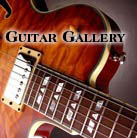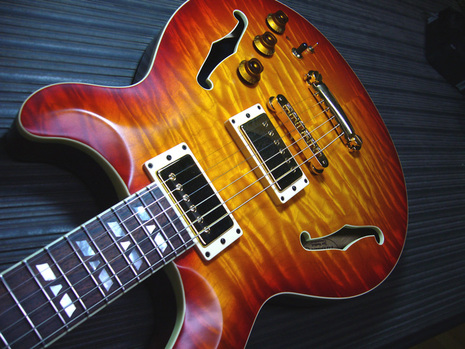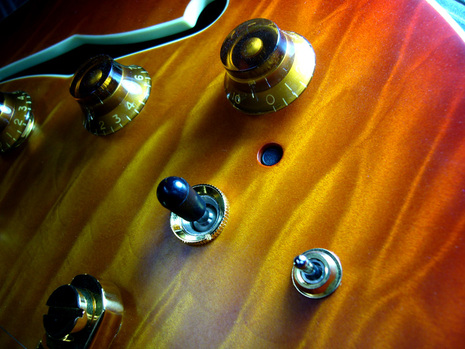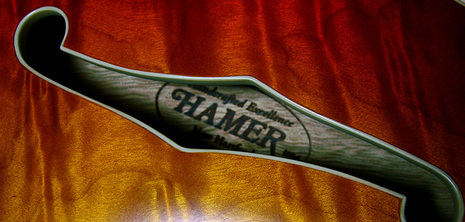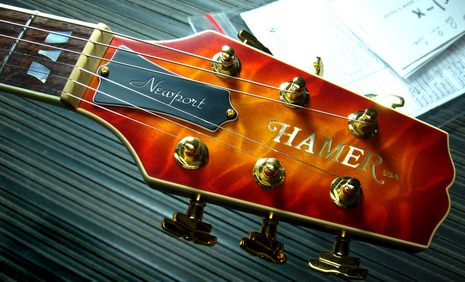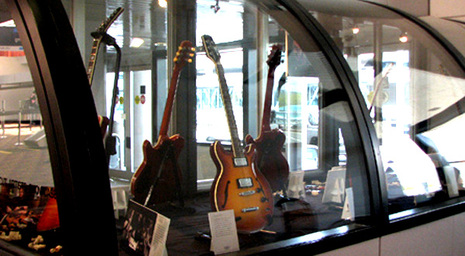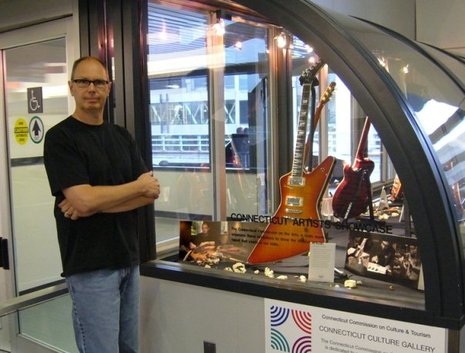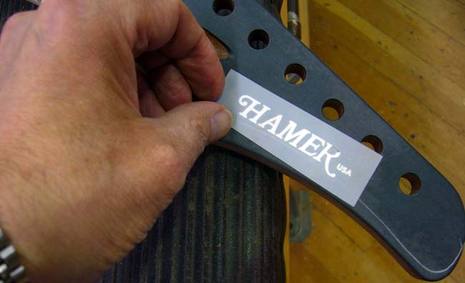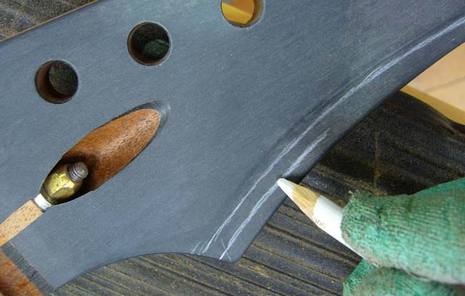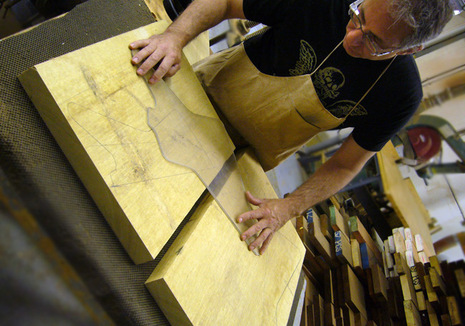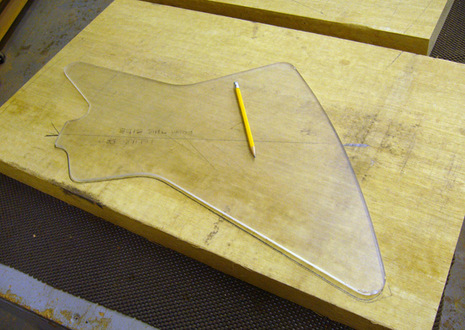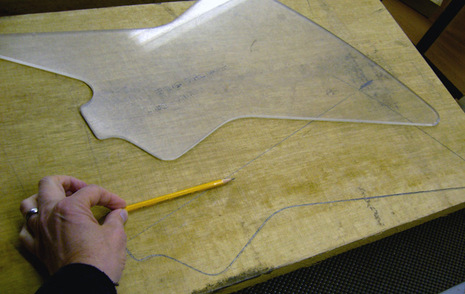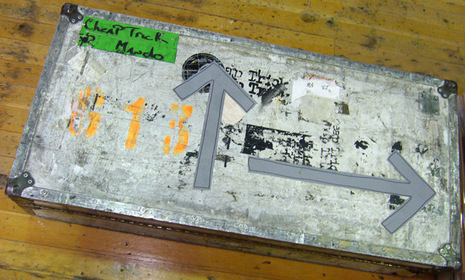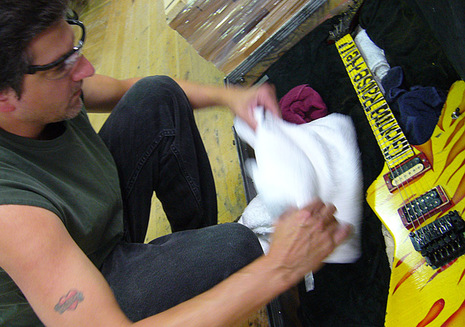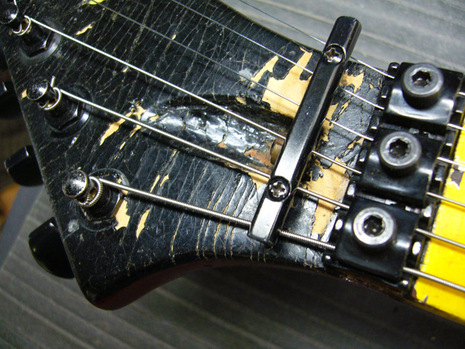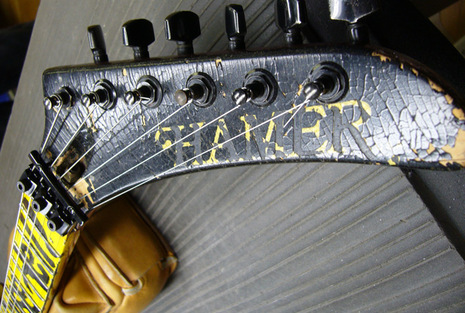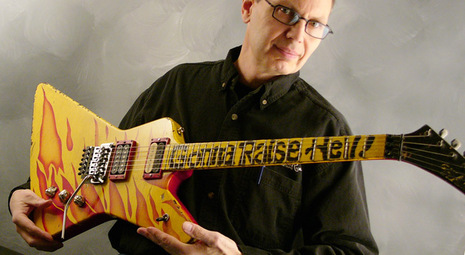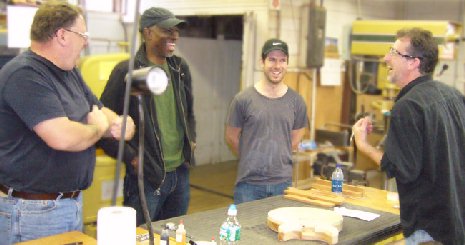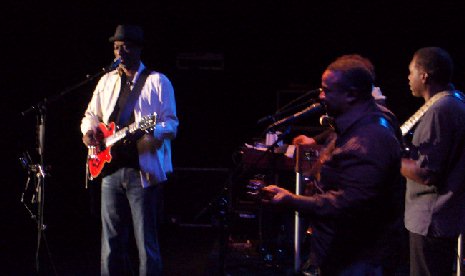
Archives
August 2008
August 08, 2008
| |
After having a wonderful vacation in Northern California I returned to our shop to find things humming away as usual. The shop is filled with so many projects, I didn't know where to point the camera first. Todd solved my problem by directing my attention to the set up room where our Baggs-equipped Newport was just being finished. | |
The acoustic electronics package had gone in without any fuss, thanks to Todd and Mike's careful pre-planning. The parts went in exactly where they had been mocked up, so our biggest assembly hurdle was cleared without incident. In this shot you can see the stereo/mono selector switch resting nicely, just below the surface of the top. The controls are for magnetic volume, magnetic tone and the third knob controls the acoustic output. The large toggle functions as normal for the humbucker selection, while the small one engages magnetic or acoustic. Overall, the guitar looks very classy with a matte lacquer finish and the acoustic sound is easily accessed and is quite good. It makes the Newport an even more versatile instrument without cluttering up or complicating the controls. The matching headstock (note the ivory string nut) and bound f-holes really complete this guitar. The guys even went so far as to make a matching matte finish truss rod cover! | |
I'll have more things to show after I clear a few items off my workbench and return some phone calls and emails... | |
August 11, 2008
| |
Hey, a cool thing happened and I just thought I'd share it with you. As I mentioned, I just got back from a vacation, and as I passed through the airport terminal in Hartford, I saw a display that had been set up of our guitars. It was in the state's Connecticut Artists Showcase, which makes pretty good sense to me because I think of our builders as artists. Of course I knew it had been done, but I didn't go to the opening ceremony or whatever they call it and had honestly forgotten about the whole thing. So when I walked through the terminal and saw the display for the first time it took a second to sink in. | |
It's pretty cool—in addition to about a half-dozen guitars, there are pieces of wood and guitar parts strewn about in the case along with chisels and other guitar making tools. Our web-guy Scott and Frank Rindone had made up some posterboard blow-ups of the our catalog with photos of the guys in the shop and it looked great. I had my wife take my picture in front of the display, just like a tourist! Now that's culture! | |
August 12, 2008
| |
A lot has happened with Glenn's guitar in the last few weeks, so we'll try to catch up. We decided to keep the traditional "GT" headstock on this model, and because Glenn wanted bevels on the body we thought that the headstock should echo that too. After Mike sketched the first draft, I put a logo overlay on the headstock to see how the whole thing would look. When we saw the overall effect, I thought that the bevel was too large. It really dominated the headstock as opposed to being a flourish like the ones on the body; so we reduced the mass of the bevel to suit the overall theme. It's important to think of the instrument as a whole rather than a collection of individual design ideas because no matter how much you like them all, if they don't work together the design fails. | |
Satisfied that we'd balanced things out, Mike proceeded with the woodworking using a sander, file and a scraper. Then it's just a matter of prepping for the paint room where we'll pick it up next time. | |
August 14, 2008
| |
We've all heard the expression "less is more," and often times that's right on the money. Here at Hamer we've been fans of minimalism since day one—often creating instruments that are more versatile than their basic layout would imply. Other times, there is a solid case for using more to create less. So it was for a recent custom order Korina Standard model with a two-piece "chevron" body. The extreme width of this guitar necessitates the use of two large slabs of African limba, culled from a single board. On very rare occasions, we procure a board that is wide enough to produce a single piece body, and the extra cost is appropriately higher. There is a third option, that uses up even more real estate, and that is the "chevron" configuration. We'll probably never find a board wide enough and thick enough to do a perfect bookmatched and chevroned body, so the next best result comes from the use of a board that is wide enough to have been a single piece body—only long enough for two. | |
First our man Enrico lays out the pieces cut from the single board, and finds a similar grain pattern for each half by eye. Then he lays the clear body template out and marks the outline for rough bandsawing. In this shot you can see the direction of the grain in relation to the centerline of the instrument. You can clearly tell how large the board must be to accommodate the length of the "wing". | |
The angle of the grain is the same as used on the flying V design, only with a V the boards can be narrow—which is why it was done that way back in 1958. It's ironic that our guitar mimics the V's look but achieves the exact opposite in terms of material yield. The fun part is that something so crucially important to the guitar is something that might not occur to the casual observer. And that's the kind of detail we like best. | |
August 25, 2008
| |
As our last post indicated, you never know when you'll run into old friends. That was the case again last week when a couple of ours burst back into the frame. A flight case arrived via FedX along with an urgent phone call telling us that Rick Nielsen's "Gonna Raise Hell" guitar needed some emergency work. | |
Here, Todd "The God" Gencarella whips the covers off in order to begin his inspection. Apparently the guitar wasn't staying in tune, and was buzzing mightily as well. Everyting pointed to a locking-nut problem, but Todd still went over every inch before making any repairs. | |
This guitar, constructed in 1982, has been used nightly to perform the Cheap Trick song of the same name. CT does a couple hundred gigs per year, so after twenty-six years, this guitar has seen its share of abuse. Being locked in trucks, cars and aircraft cargo holds in all sorts of weather takes a toll too. The nitro finish is dried and cracked to the point where it is flaking off, especially at the headstock. The Hamer logo has all but disappeared. As it turned out, the screws holding down the nut had worn themselves permanently loose and the ensuing movements had ground the nut lower and lower until the high strings dropped down onto the frets. | |
Mike plugged the original holes and drilled new ones while Todd fabricated a new nut platform shim. After reassembly, we put the old girl through some steep dives and blackout-level pull-ups—everything checked out. | |
As the FedX truck pulled away with our oversize priority package (insured for five-figures) we pondered the idea of creating a "modern" replacement. It may be time to raise a little more hell for old time's sake. | |
August 30, 2008
| |
My cell phone rang early Thursday morning—usually a sign that something needs immediate attention. Instead, it was a pleasant sounding Keb' Mo' calling from his tour bus which was headed our way. On tour with Robert Cray, the Kebmeister was playing a few miles away, and wanted to come by the shop to meet the guys. I arranged to pick him up at the venue and off I went. Keb's been playing Monaco IIIs and a Korina Newport for quite a few years now, so we decided that they could stand a once over as long as we were at it. We grabbed the guitars, collected Keb's utility guitarist Clayton Gibb and drove back to the shop. First, we brought the guitars to Todd, who determined that Keb's main Monaco could use a new nut. The constant use on stage and studio had deepened the string slots to a point where it would be good preventive medicine to put a fresh one on. The job takes about an hour, so in the meantime we all hung out in the shop looking at guitars and talking about "guitar stuff" as well as getting a little jamming in. I got a new Talladega Pro out for Keb' and Clayton to try, and it took about twenty seconds for Keb' to decide that he wanted one. Now, I know the man a little bit, and he's not the kind of person who collects guitars that he won't actually use; so I took that as a good sign. Clayton seemed to gravitate towards the Newport. He saw one being completed in the Blackcherry finish and couldn't stop talking about it all day. I think he's going to have three pickups on that one. | Here are our guests sharing a few laughs over the custom bench with Tom and Dave. |
After lunch at Chatterly's, the only restaurant in our little town of New Hartford, we picked up the guitars from Todd and went back to the Warner Theater for the sound check. The guys had done a fine job—the guitar was working perfectly and the sound check went well. During the show that night, Keb' used his red Monaco III for a majority of the electric numbers, including his two "duets" with Robert Cray. Sorry for the crummy cell phone photo from the side of the stage, but here's Keb' and Robert doing what they do best. The Monaco III held its own, sounding great and staying in tune like it should. It was a great show from two brilliant performers and it was good to see everybody and give them a glimpse into our workshop. A good time was had by all. | |
